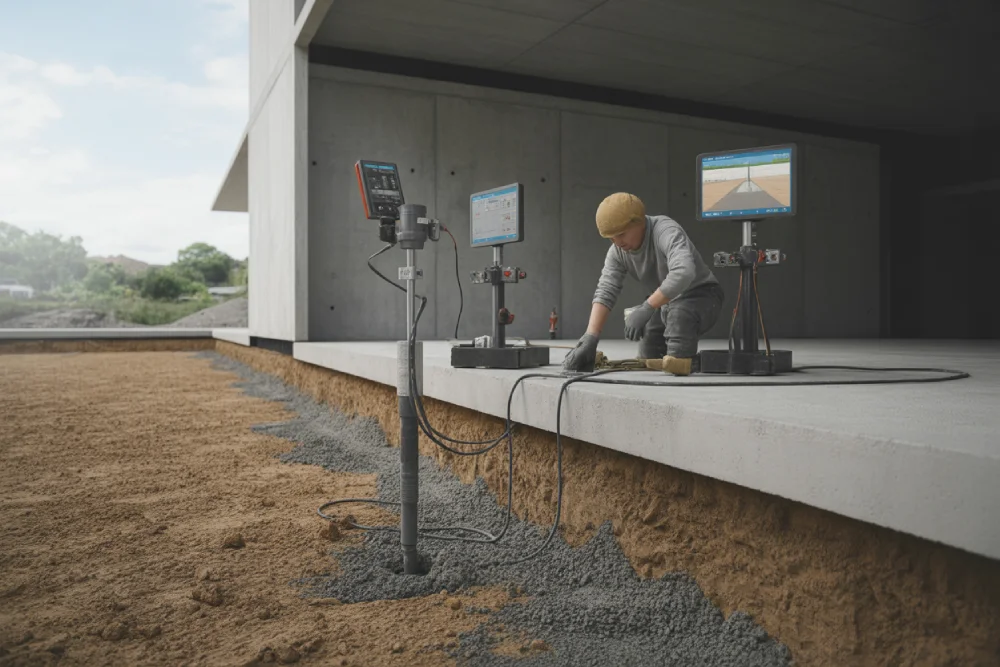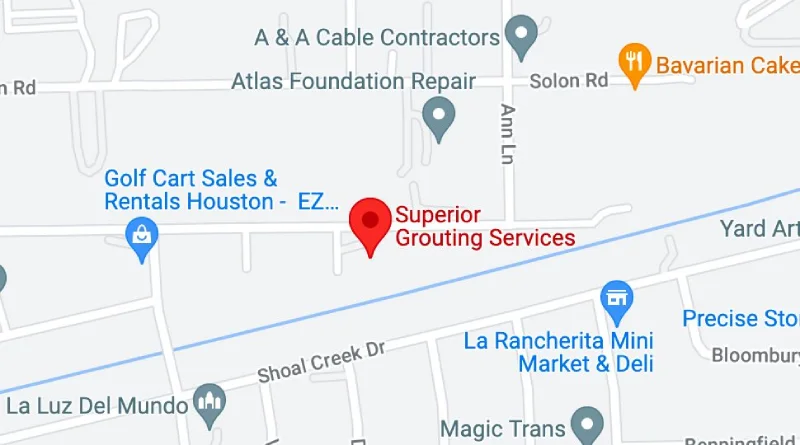Is Smart Grouting the Future of Polyurethane Injection?

Smart Grouting represents emerging research concepts in sensor integration and material science, but proven polyurethane injection technology remains the reliable, effective solution for critical infrastructure applications like levees, dams, tunnels, and water treatment facilities.
The term "Smart Grouting" appears in industry discussions about future grouting technologies, but understanding what this means requires separating marketing terminology from proven engineering solutions. For infrastructure projects requiring immediate, reliable results, traditional polyurethane injection delivers documented performance that emerging technologies cannot yet match.
Professional grouting services continue to rely on proven polyurethane injection methods because these techniques provide immediate, verifiable results for critical applications. While research into advanced materials continues, the current state of polyurethane technology already offers sophisticated solutions for complex infrastructure challenges.
Key Takeaways
- Smart Grouting terminology describes various concepts from proven digital monitoring systems to experimental self-healing materials still in laboratory research, with most advanced claims remaining years from practical infrastructure deployment.
- Proven polyurethane injection technology delivers reliable performance for critical infrastructure today, with decades of field documentation in dam stabilization, tunnel waterproofing, levee seepage control, and water treatment facility applications.
- Current digital monitoring and automated control systems represent the most practical smart grouting advances, providing real-time quality assurance documentation that satisfies stringent government and industrial project requirements.
- Self-healing polymers and embedded sensor technologies face significant technical barriers including cost, durability, environmental sensitivity, and regulatory approval, making them unsuitable for infrastructure applications for 10+ years.
- Infrastructure decision-makers should prioritize documented field performance, regulatory compliance, and proven contractor track records over experimental technology claims when selecting grouting solutions for critical applications.
- Future grouting advancement will occur through incremental improvements to established polyurethane methods rather than revolutionary new approaches, with near-term developments focusing on enhanced monitoring capabilities and refined material formulations.
Understanding "Smart Grouting" Terminology
The grouting industry uses the term "Smart Grouting" to describe several different concepts, some proven and others still in development.
Current Industry Definitions
Smart Grouting can refer to multiple approaches with varying levels of practical application:
Digital monitoring systems that track injection parameters in real time represent the most established "smart" technology currently used in professional grouting operations. These systems provide data logging, pressure monitoring, and quality control verification during installation.
Automated mixing and delivery systems improve consistency and reduce human error in grouting applications. These technologies are proven and widely available for large-scale infrastructure projects.
Advanced material formulations with predictable performance characteristics under specific conditions demonstrate sophisticated engineering, though they follow established chemical principles rather than introducing fundamentally new capabilities.
Research-Stage Concepts
Some "Smart Grouting" discussions reference technologies that remain primarily in laboratory research:
- Self-healing materials that repair damage autonomously
- Embedded sensors that monitor structural conditions
- Materials that adapt characteristics based on environmental changes
- Real-time curing monitoring at the molecular level
| Technology Type | Current Status | Infrastructure Readiness | Timeframe |
| Digital Monitoring Systems | Proven, widely available | Ready for deployment | Current use |
| Automated Mixing Equipment | Established technology | Field-tested and reliable | Current use |
| Self-Healing Polymers | Laboratory research | Years from practical application | 5-10+ years |
| Embedded Material Sensors | Early development | Unproven for infrastructure | 10+ years |
| Adaptive Material Response | Conceptual research | Not yet demonstrated at scale | 10+ years |
Realistic Assessment for Infrastructure
Infrastructure projects serving municipalities, government agencies, and industrial facilities require proven performance under demanding conditions. Laboratory concepts, while scientifically interesting, cannot substitute for documented field performance in critical applications.
Proven Polyurethane Injection Technology
Current polyurethane grouting technology offers sophisticated capabilities that address complex infrastructure challenges effectively.
Established Performance Capabilities
Modern polyurethane injection provides reliable solutions for demanding applications:
Water-activated expansion allows polyurethane to seek out and seal leak pathways in saturated conditions. This reactive capability effectively addresses active water infiltration in tunnels, culverts, and underground structures.
Controlled reaction times enable engineers to select formulations appropriate for specific applications. Fast-reacting materials stop high-flow leaks quickly, while slower formulations provide deep penetration for soil stabilization and void filling.
Predictable expansion ratios allow accurate calculation of material quantities and injection patterns. Professional contractors use established engineering principles to design effective treatment programs.
Proven durability in challenging environments demonstrates long-term performance. Properly installed polyurethane grouting provides decades of effective service in applications ranging from dam foundations to water treatment facilities.
Field-Tested Applications
Infrastructure projects across the country rely on polyurethane injection for critical applications:
- Dam and levee seepage control where failure could cause catastrophic flooding
- Tunnel waterproofing for transportation and utility infrastructure
- Water treatment facility repairs requiring minimal service disruption
- Foundation stabilization for industrial facilities and critical structures
- Emergency leak repairs when immediate results are essential
Quality Control and Verification
Current polyurethane injection technology includes comprehensive quality control measures:
Real-time monitoring during injection tracks pressure, flow rates, and material consumption. This data verifies complete treatment and identifies any issues requiring additional attention.
Pre-injection testing establishes baseline conditions and guides treatment design. Professional contractors conduct thorough site assessment before beginning work.
Post-installation verification confirms treatment effectiveness through visual inspection, flow testing, and structural surveys. This documentation provides confidence in long-term performance.
Advanced Monitoring and Control Systems
The most practical "smart" grouting technologies involve improved monitoring and control of established injection processes.
Digital Data Collection
Modern grouting equipment incorporates digital systems that enhance quality control:
- Automated pressure and flow monitoring
- GPS-tracked injection point locations
- Real-time material consumption tracking
- Environmental condition logging
- Equipment performance verification
These systems create comprehensive documentation of grouting operations, improving quality control and providing verification for engineers and project owners.
Automated Process Control
Advanced equipment automates critical aspects of the grouting process:
Proportioning systems maintain precise ratios of polyurethane components, ensuring consistent material properties throughout large-scale applications. This automation eliminates human error in material preparation.
Pressure regulation adjusts injection parameters automatically based on resistance encountered during placement. This capability optimizes material distribution and prevents over-pressurization that could damage existing structures.
Sequential injection control coordinates multiple injection points in complex applications. Automated systems ensure proper sequencing for curtain grouting and other applications requiring coordinated placement patterns.
| System Type | Primary Benefit | Infrastructure Application | Cost Factor |
| Digital Monitoring | Quality documentation | All major projects | Moderate |
| Automated Proportioning | Consistent material properties | Large-scale applications | Moderate |
| Pressure Control | Optimized placement | Deep injection, sensitive structures | Low-Moderate |
| Sequential Control | Complex pattern coordination | Curtain grouting, barrier systems | Moderate-High |
Benefits for Critical Infrastructure
Advanced monitoring and control systems provide specific advantages for infrastructure applications:
Documentation requirements for government and industrial projects benefit from comprehensive digital records. Automated systems create detailed logs that satisfy stringent quality assurance requirements.
Consistency across large projects improves when automated systems eliminate operator variables. This consistency is particularly valuable for applications requiring uniform treatment across extensive areas.
Real-time problem detection allows immediate response to unexpected conditions. Monitoring systems alert operators to issues such as unexpected material consumption or pressure anomalies that could indicate unforeseen site conditions.
Research Developments in Polymer Science
Laboratory research into advanced polymers explores concepts that may eventually influence grouting technology, though practical application remains distant.
Self-Healing Material Research
Academic research investigates polymers with autonomous repair capabilities. These materials incorporate chemical mechanisms that allow damaged bonds to reform without external intervention.
Current research status: Self-healing polymers demonstrate interesting properties in controlled laboratory conditions. However, these materials face significant challenges for infrastructure applications:
- Performance degrades rapidly outside laboratory conditions
- Self-healing mechanisms require specific environmental conditions
- Material costs are prohibitively expensive for infrastructure scale
- Long-term durability in real-world conditions remains unproven
- Mechanical properties are generally inferior to conventional materials
Practical limitations: Infrastructure applications require materials that function reliably across wide temperature ranges, in contaminated groundwater, under constant hydrostatic pressure, and for decades without maintenance. Current self-healing polymers cannot meet these requirements.
Embedded Sensor Concepts
Some research explores incorporating sensors into structural materials to monitor conditions over time. This concept remains largely theoretical for grouting applications.
Technical challenges for sensor integration include:
- Sensors must survive the chemical environment during material placement
- Power sources for long-term monitoring present practical obstacles
- Signal transmission through concrete and soil limits utility
- Sensor costs make large-scale application economically impractical
- Reliability over decades in harsh environments is undemonstrated
Alternative approaches: External monitoring systems already provide structural health information without requiring sensors embedded in grout materials. These established technologies offer practical solutions today.
Adaptive Material Properties
Research into materials that change characteristics in response to environmental conditions explores interesting scientific concepts. However, infrastructure applications generally benefit from materials with stable, predictable properties rather than adaptive behavior.
Infrastructure requirements favor materials that maintain consistent performance despite environmental variations. Controlled, predictable material behavior allows accurate engineering analysis and reliable long-term performance.
Practical Implementation Considerations
Infrastructure decision-makers must evaluate technologies based on proven performance, regulatory compliance, and documented reliability rather than emerging research concepts.
Regulatory and Standards Compliance
Government and industrial infrastructure projects require materials and methods that meet established standards:
Testing and certification requirements cannot be met by experimental materials still in research phases. Proven polyurethane formulations have decades of testing data and regulatory approvals for infrastructure applications.
Engineering specifications developed by agencies and professional organizations reference established technologies with documented performance. Experimental approaches do not appear in these specifications because performance data does not yet exist.
Liability considerations favor proven technologies with established track records. Using experimental methods in critical infrastructure applications creates unnecessary risk for project owners and contractors.
Cost-Benefit Analysis for Infrastructure
Infrastructure budgets require cost-effective solutions that deliver reliable results:
| Consideration | Proven Polyurethane | Emerging Technologies |
| Material Cost | Established, competitive | Significantly higher (often 10x+) |
| Installation Cost | Standard rates | Specialized requirements increase costs |
| Performance Documentation | Decades of field data | Limited or no field data |
| Long-Term Maintenance | Well-understood requirements | Unknown maintenance needs |
| Warranty Coverage | Industry-standard coverage | Limited or no warranty available |
| Insurance Acceptance | Standard coverage | May be uninsurable |
Project Timeline Realities
Critical infrastructure projects require solutions available for immediate deployment:
Procurement timeframes for government projects favor materials and methods that meet established specifications. Experimental technologies cannot be specified because performance data and regulatory approvals do not exist.
Emergency applications demand proven solutions that deliver immediate results. Research-stage technologies are inappropriate for situations requiring rapid, reliable performance.
Long-term planning for infrastructure projects spans decades. Technology selections must consider not just current capabilities but also long-term availability of materials, expertise, and support services.
Future Technology Integration Pathways
Realistic advancement in grouting technology will occur through incremental improvements to proven methods rather than revolutionary new approaches.
Likely Near-Term Developments
Professional grouting contractors can expect gradual technology improvements over the next 5-10 years:
Enhanced monitoring capabilities will provide more detailed data about injection processes and long-term performance. These improvements build on existing digital monitoring systems rather than requiring fundamentally new approaches.
Improved material formulations will offer better performance characteristics for specific applications. Chemical engineering advances will incrementally improve properties such as reaction time control, expansion ratios, and environmental resistance.
More sophisticated automation will streamline grouting operations for large-scale projects. However, these advances represent evolution of existing automated systems rather than revolutionary new capabilities.
Realistic Innovation Timeline
Infrastructure professionals should maintain realistic expectations about technology development:
Short-term (1-3 years): Refinements to existing polyurethane formulations and monitoring systems. These incremental improvements offer practical benefits without requiring changes to specifications or procedures.
Medium-term (3-7 years): Possible introduction of new polymer chemistries that offer specific performance advantages. These materials will require extensive testing and regulatory approval before infrastructure application.
Long-term (7-15 years): Potential for genuinely new approaches such as sensor-integrated materials or adaptive polymers, if laboratory research successfully addresses current technical limitations and cost barriers.
Integration with Existing Infrastructure Programs
Any future grouting technology must integrate with established infrastructure maintenance programs:
- Compatibility with existing specifications and standards
- Training programs for contractor personnel
- Availability of equipment and materials nationwide
- Acceptance by engineering community and regulatory agencies
- Documented performance under actual field conditions
Professional Contractor Selection Criteria
Infrastructure owners should select grouting contractors based on demonstrated expertise with proven technologies rather than claims about experimental approaches.
Essential Contractor Qualifications
Professional pressure grouting companies demonstrate specific qualifications:
Project experience with similar infrastructure applications provides confidence in successful outcomes. Contractors should document previous work on comparable projects with verifiable results.
Engineering expertise ensures appropriate material selection and application methods for specific site conditions. Professional contractors employ experienced personnel who understand complex infrastructure challenges.
Quality control capabilities include proper equipment, testing procedures, and documentation systems. Comprehensive quality assurance protects project owners and ensures long-term performance.
Regulatory compliance knowledge demonstrates understanding of applicable standards, permitting requirements, and environmental regulations. This expertise prevents project delays and compliance issues.
Evaluating Technology Claims
Infrastructure decision-makers should critically assess contractor claims about grouting technologies:
- Request documentation of proven field performance, not laboratory studies
- Verify regulatory approvals and standards compliance
- Confirm availability of materials and expertise for long-term support
- Evaluate whether proposed approaches meet project specifications
- Consider whether claims about revolutionary technologies are realistic
Warning Signs in Contractor Selection
Certain contractor claims should raise concerns for infrastructure projects:
Unverified performance claims: Contractors who cannot provide documentation of actual field performance with verifiable project references may lack genuine expertise.
Experimental approaches for critical applications: Using unproven technologies in applications where failure has serious consequences demonstrates poor judgment.
Resistance to standard specifications: Contractors who discourage or dismiss established specifications may lack capability to meet industry standards.

